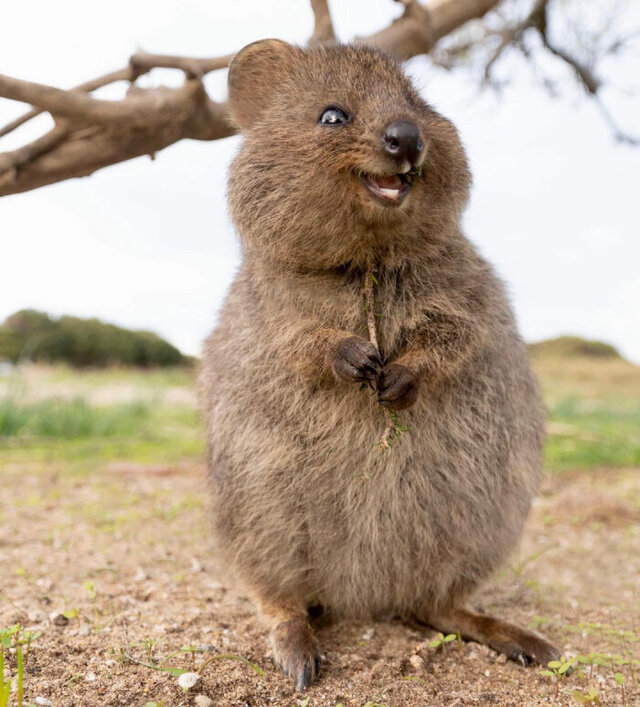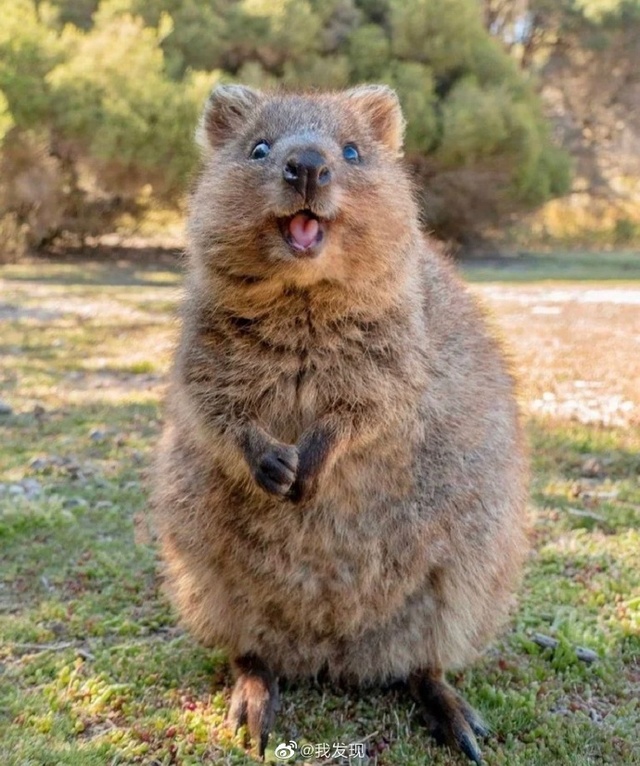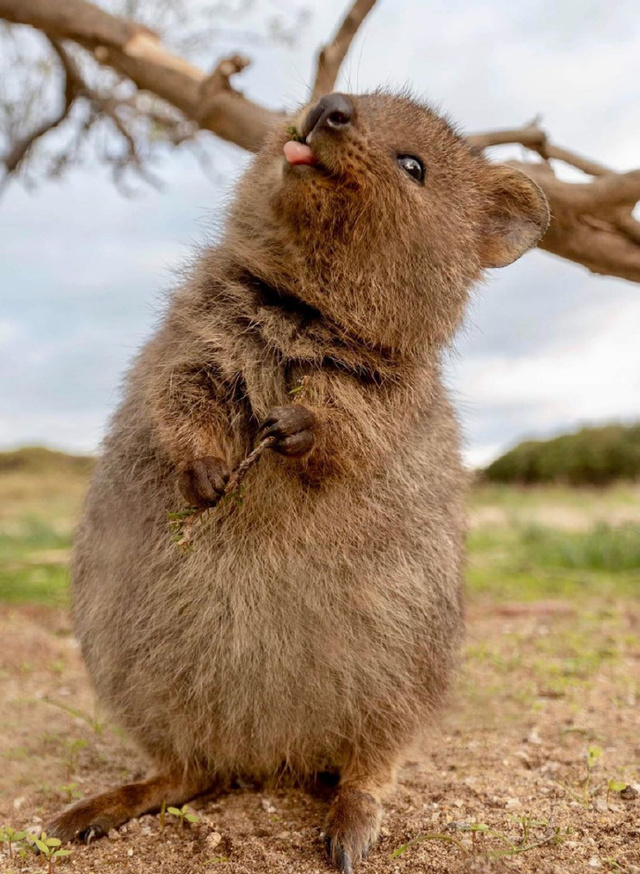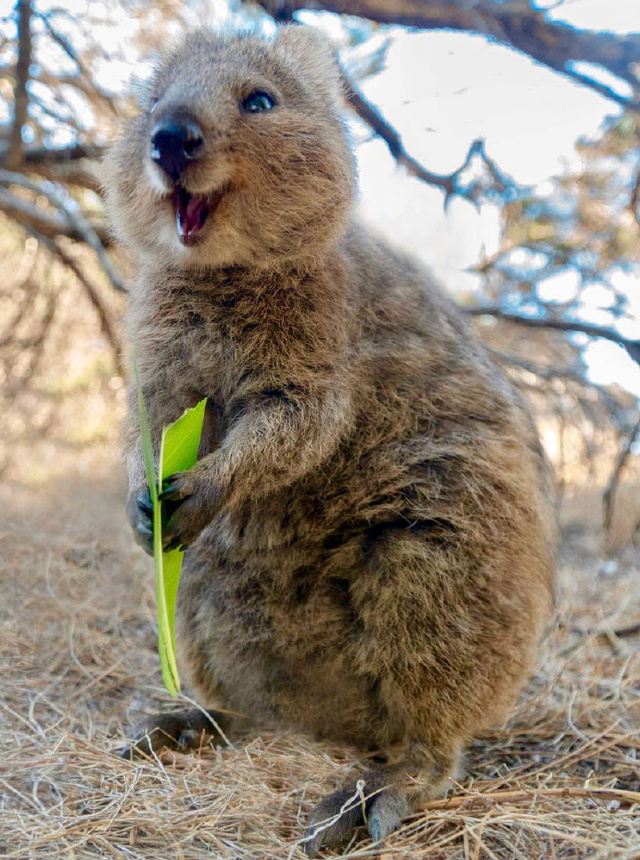Setonix brachyurus
IUCN
ENBasic Information
Scientific classification
- name:Setonix brachyurus
- Scientific Name:Short-tailed grey wallaby, short-tailed wallaby
- Outline:Rodents
- Family:S.brachyurus Setonix Macropodidae Diprotodontia Marsupialia Mammalia
Vital signs
- length:40-54cm
- Weight:1.5-4.5kg
- lifetime:10years
Feature
It is short and fat, with well-developed hind legs, round ears, a short and wide head, and coarse brown hair all over its body. The area around its face and neck is slightly red. Compared with other kangaroos, its tail is shorter, hence the name. It is one of the smallest kangaroos and has an amazing jumping ability. It can jump vertically up to 1.5 meters, which is equivalent to 3 to 4 times its body length. Its smile is called "the happiest animal in the world"
Distribution and Habitat
It occurs in a variety of habitats, most commonly in dense forests, open woodlands, and scrub close to freshwater areas. Although it seems to prefer dense vegetation and moist areas, it also lives in large numbers on Rottnest Island and Bald Head Island near Albany, which have seasonally dry and harsh environments.
Appearance
It is short and stocky, with well-developed hind legs, short, rounded ears and a bare nose. It has a short, broad head with a dark-striped forehead. It is covered with coarse brown hair, with a reddish tint around the face and neck. It is less than 60 cm tall. Its fur is dense, rough, short, brownish-grey, lighter on the back, and lighter on the lower limbs, which allow it to move through dense grass at great speed. It is short and stocky, with a hunched posture. It has a distinct short tail. Unlike its peers, the quokka has short, well-developed hind legs and almost no fur on its tail. The quokka weighs 1.5-4.5 kg, is 40-54 cm long, and has a tail length of 26-30 cm. The quokka weighs 1.5-4.5 kg, is 40-54 cm long, and has a tail length of 26-30 cm.
Details

The quokka (scientific name: Setonix brachyurus) is a marsupial mammal of the family Macacuidae. It is one of the smallest kangaroos and looks like a mouse. It is called "the happiest animal in the world" because of its chubby face and "sweet" smile. They are very friendly and are a major tourist feature of the local area, and are very popular with tourists. It has a short and fat body, well-developed hind legs, short and round ears and a bare nose. The head is short and wide, with a dark-striped forehead. The whole body is covered with coarse brown hair, with a slightly reddish color around the face and neck. The body is less than 60 cm tall. The fur is dense, rough, short brown-gray hair, and the fur on the back is lighter, which is lighter but allows it to move through dense grass at great speed. The body is short and stout, with a hunched posture. The obvious short tail. Unlike its peers, the quokka has short and well-developed hind legs and almost no fur on its tail. The weight range of the quokka is 1.5-4.5 kg, the body length is 40-54 cm, and the tail length is 26-30 cm. The weight range is 1.5-4.5 kg, the body length is 40-54 cm, and the tail length is 26-30 cm. The average lifespan is 10 years.
Quokkas live on Rottnest Island, and a few live in the southwestern forests of the Australian mainland. They live in swampy shrublands and prefer to move at night. They live in family groups. They are herbivores and eat a variety of grasses and shrubs. When food is scarce, they can use the fat stored in their tails to obtain energy. The gestation period is 26 days, and females give birth to one cub at a time.
Quokkas are a type of wallaby, a small marsupial unique to Australia. Due to predation by wildlife (cats and foxes), changing fire patterns and habitat loss, its current population is rare and it is listed on the IUCN Red List of Threatened Species - Endangered.

Geographical range
The quokka (Setonix brachyurus), the only member of the genus Setonix, is a small kangaroo, about the size of a house cat.
It is found in a variety of habitats, most commonly in dense forests, open woodlands and scrub close to freshwater areas. Although it seems to prefer dense vegetation and moist areas, it also lives in large numbers on Rottnest Island and Bald Head Island near Albany, which are seasonally dry and harsh environments. The quokka lives in a group lifestyle on a small piece of land in the Two Bays Nature Reserve, where it lives with Gilbert's long-nosed potoroo. In mainland Australia, the quokka seems to be limited to swampy areas surrounded by dense vegetation. The preferred residence is the bush or some other shaded area, enough to avoid the summer heat, where it spends most of the year, but sometimes changes locations. Like other marsupial mammals, the quokka is a herbivore and is active at night.
It is endemic to southwestern Australia, including the Rottnest (17 km2) and Bald (8 km2) Islands, and Breaksea Island (1 km2, Abbott 2006). It was originally distributed from Moore River, 100 km north of Perth, through the higher rainfall parts of the southwest, eastward along the south coast to at least the Green Ranges, 60 km northeast of Albany. As of 2012, the northernmost record of the range is in the Darling Ranges east and northeast of Perth. In addition, the species is sporadically present along the south coast east of the Green Ranges, including an isolated subpopulation in Stirling Ranges National Park.

Morphological characteristics
The quokka weighs 2.5–5 kg (5.5–11.0 lb) and is 40–54 cm (16–21 in) long. Its tail is 25–30 cm (9.8–11.8 in), which is quite short for a member of the kangaroo family. The quokka has a stocky build, rounded ears, and a short, broad head. Despite being a small kangaroo, it can climb small trees and shrubs. Its coarse fur is brownish-grey, fading to a lighter yellowish color underneath.
Quokkas are not afraid of humans, and it is common for humans to approach them, especially on Bald Head Island near Albany. However, it is illegal for the public to touch the animals in any way on the island, and the relevant authorities on the island will issue a violation notice with a fine of AUD 300. In addition, if the prosecutor prosecutes, it may result in a fine of up to AUD 2,000.
Quokkas are one of the first Australian mammals discovered by Europeans. Dutch sailor Samuel Volckertzoon wrote of seeing "wild cats" on Rottnest Island in 1658. In 1696, Willem de Vlamingh mistook them for giant rats and named the island "Rotte nest", from the Dutch word for "rat's nest". The word quokka may be derived from the Noongar word gwaga.
Ecology
In the wild, quokkas are confined to a small area in southwestern Western Australia and live in small family units. There is a large population on Rottnest Island, where quokkas occupy a variety of habitats, from semi-arid scrub to plantations. A small population lives on Bald Head Island near Albany, where foxes and cats are absent.

Populations
Although quokkas are common on coastal islands, their distribution is very limited and they are listed as vulnerable. On the Australian mainland, they are threatened by predators such as foxes, and therefore require dense ground cover for shelter. Widespread deforestation and agricultural development have reduced their habitat, contributing to the species' decline. The clearing and burning of swamps, as well as the introduction of cats, dogs, and dingoes, have exacerbated the problem. In addition, the quokka generally has one litter per year, successfully raising one mouse per year. Although it is able to reproduce continuously, usually reproducing the day after the birth of a pup, the small number of litters, coupled with its restricted range and the threat of predators, makes this small kangaroo very rare on its native mainland.
Habitat
Groups: Quokkas live in small family units, governed by a dominance hierarchy formed by adult males among them, and this hierarchy is usually stable except on hot summer days. The overlapping ranges of quokka families reflect their non-territorial nature. They are very friendly animals, and most of the time, they will share their habitat peacefully and will not argue with 150 other individuals in their territory. But in the hot summer, males will also fight for the best shelter.
Foraging: The quokka rests collectively in dense vegetation during the day, but is very active at night, often coming out in groups to forage at night under the cover of vegetation. They feed on local grasses, leaves, seeds and rhizomes, chewing them up immediately after swallowing, and studies have shown that a local flowering plant is one of the quokka's favorite foods. They often dig holes or peel succulent plants such as cacti to obtain fresh water, although they may not have drunk water for several months, due to their extraordinary ability to reuse some of their waste.
Survival: The heat, dryness and dehydration caused by long periods of no rain cause individuals farther from water sources to have a higher mortality rate. In addition, high temperatures cause plants to dehydrate and lack nitrogen, which the kangaroos will also lack. The quokka may suffer from dehydration, but studies have shown that these kangaroos have excellent body temperature regulation ability and can cope with temperatures as high as 44°C. The quokka's short stature and superb jumping ability make them masters of the bush. They create escape tunnels in the bushes or dense vegetation to deal with the threat of predators.
Perception: Quokkas get information through touch and chemical signals.
Reproduction method
Viviparous, with an average of 1 baby per year. The average estrus cycle of females is 28 days. In captivity, they can reproduce all year round, but in the wild, females are in estrus from August to January of the following year. The day after the birth of the cub, the female will enter the next embryonic dormancy period. In the wild, they usually mate between January and March. After a short 4-week pregnancy period, the female mouse will give birth to the next mouse, called a joey. The pouch period usually lasts for 6 or 7 months. At this stage, the joey will slowly grow up and know how to crawl out of the pouch. When it is panicked or cold, the joey will crawl back into the pouch, but it still needs more than 2 months of lactation.
The average time to sexual maturity for males is 389 days, and for females is 252 days. The average lifespan of males in the wild is 10 years, and that of females in captivity is 7 years. The combined average lifespan is 5 years.
The global number of mature individuals is estimated to be 7850-17150. Regional population estimates are as follows: 4000-8000 on Rottnest Island, 500-2000 on Bald Head Island, 150 in northern Jarrah forests, 2000-5000 in southern forests, and 1200-2000 on the southern coast.
Threatening factors
Before the arrival of European settlers in the southwestern coastal areas of Australia, the quokka was numerous and widespread. However, the introduction of domesticated predators such as cats, foxes, and dogs by humans, as well as animals attracted by human settlements including predatory birds and wild dogs, have caused a significant decline in the population of the quokka in its habitat. They have only a small range of natural habitats on the Australian mainland, due to the increasing human settlement of their habitats, and the reduction of their daytime resting sites is considered to be a manifestation of population decline. In addition to this, the development of Rottnest Island for recreation has reduced the habitat of the quokka and also increased the spread of diseases. The large number of tourists attracted each year feed them, changing their feeding habits and diurnal habits, which is often not conducive to their health.

Conservation measures
Australia developed a recovery plan for the quokka population in December 2013. The Western Australian Department of Environment and Conservation is responsible for the protection of the quokka, and the department also manages most of the quokka's habitat, which is located in state forests, national parks and nature reserves, including Bard Island. Australia has conducted a lot of research on the ecology and conservation of the quokka in the northern Jarrah Forest, and special surveys have been carried out elsewhere in its range. Logging Management Guidelines have been developed (Burrows and Liddelow, 2005), as well as Adaptive Guidelines for Fire Management (Burrow et al., 2007). Rottnest Island is managed primarily for recreation by the Rottnest Island Authority.







